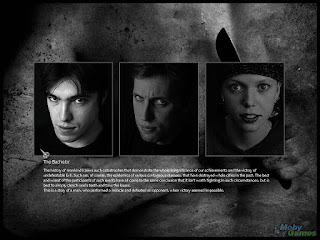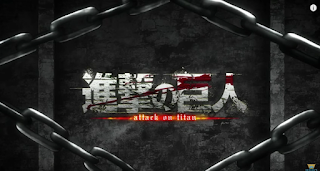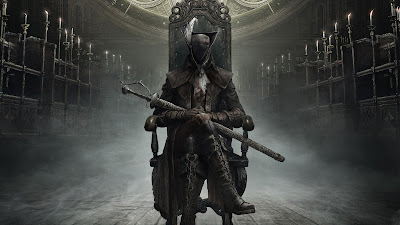The Narrative of Pathologic (contains heavy spoilers for the game)
Firstly I wanted to comment on Henry Jenkins' view of what a story is since he states that
"In its richest form, storytelling -- narrative -- means the reader's surrender to the author. The author takes the reader by the hand and leads him into the world of his imagination. The reader has a role to play, but it's a fairly passive role: to pay attention, to understand, perhaps to think... but not to act"
For me, such quote raises many questions such as why should a reader not be able to act in the story? or, could a game with different endings and choices be considered a story that the author just expanded to harbour different narratives according to different choices? Furthermore, I believe it is very much false to state that games that allow for storytelling are 'walking simulators' since there are many games, The Witcher 3, without going further, that disprove this theory by having well developed characters and story in addition to good gameplay. After all, nothing less could be expected from a game that is based on a book.
Nonetheless, today I wanted to discuss Pathologic, a game that Henry Jenkins would probably enjoy (and not because of the fact that children in-game will trade you ammo or drugs for needles and nuts). The game is so complex and contains such an amount of nuances that it would take ages to cover everything so unfortunately I will have to stick to analysing it on quite a superficial level. Pathologic dismisses any power fantasy that the player may have by grounding them with a harsh blow of 'reality' because despite you trying your best to be heroic and save everyone, the world around you does not care, seeming unfair in many occasions and thus somewhat fulfilling Henry Jenkins' idea that the reader should be, to put it in some way, powerless in regards to the narrative. Still you can act but mostly are unable to predict the consequences to what you do.
You can play as any of three characters, all doctors, that have unique backstories and will each unlock different parts of the narrative in their mostly futile attempts to stop the Sand Plague in the 12 available in-game days.
To perpetrate the hopelessness of the game, it starts with the murder of the man that you are looking for, given that you follow the logical order and start by using the Bachelor. Not only this but the three main families of the game, Kains, Vlads and Saburovs alike will constantly lie to you and toy with you, even becoming hostile sometimes, however, this can only be discovered by playing through with different characters. It is still evident in their dialogue, without being completely aware of what is happening, that something is off.
Pathologic launches the player into a world of despair where your enemy is intangible and unstoppable, it can only be slowed. You have to keep certain people alive to achieve the true ending but you will also watch many more, including those individuals if you are not careful, die. You will see the nameless town-on-Gorkhon decay before your eyes as people gradually become infected, prices of resources increase exponentially and you have to make decisions that grind at your sense of morality as you choose to either survive or help that sick person who is looking for comfort from the only person they believe can help them in their last moments. Hunger, thirst, exhaustion and time are other unnamed enemies that will work against you and will quite likely kill the inexperienced player or make them miss indispensable quests that could only be carried out at a certain time.
Something that immediately caught my eye about Pathologic was how fights in the game are nearly exclusively a storytelling device rather than a gameplay mechanic; they remind you of your fragility as a doctor, that you are not a warrior as you will easily be killed off by thieves or other enemies. In addition, these fights are absent at the start of the game and serve as an indicator of the spreading of the plague and the decay and corruption of the town that you are trying your best to save. Some players have also talked about the controls in general being cumbersome possibly intentionally as they still evoke that frustration that not only the character will feel for their decisions but you as the player too.
Pathologic is heavy on environmental storytelling, for example how the town can be easily inferred to be located in Siberia due to the architecture, the steppe and the names of the characters. Moreover, infected districts will be coated in a sickly green atmosphere and the music paired to them will make you feel uncomfortable and very possibly scared as you travel their dangerous plague and crime-ridden streets (to be honest I think the sound design is absolutely genius so I if you want to admire the music of the game you can do so here). The aura of mystery and unease is also upheld by the superstitiousness of the NPC's which is especially notable when regarding the always visible buildings of the Polyhedron and the Abattoir.
A final thing to be mentioned is that from the first instance the game breaks the fourth wall by having two enigmatic figures, the Executor and the Tragedian address you directly as the player serving as a tutorial. These characters are recurring and present you with options to answer certain dialogues, particularly near the ending as either the player or the character you are playing as. This is also due to the fact that at the end of the game your character finds out that the whole town and even they themselves are the result nothing else but two children playing with toys, creating the twisted story of the Sand Plague as a way to cope with the loss of a loved one. Essentially this creates a narrative within a narrative. After this, your character is returned to the town and asked to decide about its fate.
Many have expressed a feeling of betrayal when the falseness of it all is exposed, even when from before booting up the game the player knows that its only that, a game. Personally, I think that this is partly due to the extremely immersive atmosphere of the town that immediately draws you in with unanswered questions and a sense of wonder and dread. But in the end this reveal could be meant for us to come to the realisation that even if the game is not real, the experience still matters and I would recommend everyone to give Pathologic a chance if they feel like they have enough patience to live through the unique adventure that it is.
"In its richest form, storytelling -- narrative -- means the reader's surrender to the author. The author takes the reader by the hand and leads him into the world of his imagination. The reader has a role to play, but it's a fairly passive role: to pay attention, to understand, perhaps to think... but not to act"
For me, such quote raises many questions such as why should a reader not be able to act in the story? or, could a game with different endings and choices be considered a story that the author just expanded to harbour different narratives according to different choices? Furthermore, I believe it is very much false to state that games that allow for storytelling are 'walking simulators' since there are many games, The Witcher 3, without going further, that disprove this theory by having well developed characters and story in addition to good gameplay. After all, nothing less could be expected from a game that is based on a book.
Nonetheless, today I wanted to discuss Pathologic, a game that Henry Jenkins would probably enjoy (and not because of the fact that children in-game will trade you ammo or drugs for needles and nuts). The game is so complex and contains such an amount of nuances that it would take ages to cover everything so unfortunately I will have to stick to analysing it on quite a superficial level. Pathologic dismisses any power fantasy that the player may have by grounding them with a harsh blow of 'reality' because despite you trying your best to be heroic and save everyone, the world around you does not care, seeming unfair in many occasions and thus somewhat fulfilling Henry Jenkins' idea that the reader should be, to put it in some way, powerless in regards to the narrative. Still you can act but mostly are unable to predict the consequences to what you do.
You can play as any of three characters, all doctors, that have unique backstories and will each unlock different parts of the narrative in their mostly futile attempts to stop the Sand Plague in the 12 available in-game days.
Playable characters: the Bachelor, the Haruspex and the Changeling.
To perpetrate the hopelessness of the game, it starts with the murder of the man that you are looking for, given that you follow the logical order and start by using the Bachelor. Not only this but the three main families of the game, Kains, Vlads and Saburovs alike will constantly lie to you and toy with you, even becoming hostile sometimes, however, this can only be discovered by playing through with different characters. It is still evident in their dialogue, without being completely aware of what is happening, that something is off.
Pathologic launches the player into a world of despair where your enemy is intangible and unstoppable, it can only be slowed. You have to keep certain people alive to achieve the true ending but you will also watch many more, including those individuals if you are not careful, die. You will see the nameless town-on-Gorkhon decay before your eyes as people gradually become infected, prices of resources increase exponentially and you have to make decisions that grind at your sense of morality as you choose to either survive or help that sick person who is looking for comfort from the only person they believe can help them in their last moments. Hunger, thirst, exhaustion and time are other unnamed enemies that will work against you and will quite likely kill the inexperienced player or make them miss indispensable quests that could only be carried out at a certain time.
Children in the town who can be bartered with, one of the only ways to get resources and survive.
Something that immediately caught my eye about Pathologic was how fights in the game are nearly exclusively a storytelling device rather than a gameplay mechanic; they remind you of your fragility as a doctor, that you are not a warrior as you will easily be killed off by thieves or other enemies. In addition, these fights are absent at the start of the game and serve as an indicator of the spreading of the plague and the decay and corruption of the town that you are trying your best to save. Some players have also talked about the controls in general being cumbersome possibly intentionally as they still evoke that frustration that not only the character will feel for their decisions but you as the player too.
Pathologic is heavy on environmental storytelling, for example how the town can be easily inferred to be located in Siberia due to the architecture, the steppe and the names of the characters. Moreover, infected districts will be coated in a sickly green atmosphere and the music paired to them will make you feel uncomfortable and very possibly scared as you travel their dangerous plague and crime-ridden streets (to be honest I think the sound design is absolutely genius so I if you want to admire the music of the game you can do so here). The aura of mystery and unease is also upheld by the superstitiousness of the NPC's which is especially notable when regarding the always visible buildings of the Polyhedron and the Abattoir.
Image of an infected district with its characteristic colour and foreboding 'scarecrows'
The Polyhedron
The Abattoir
Executor on the left and Tragedian on the right.
Many have expressed a feeling of betrayal when the falseness of it all is exposed, even when from before booting up the game the player knows that its only that, a game. Personally, I think that this is partly due to the extremely immersive atmosphere of the town that immediately draws you in with unanswered questions and a sense of wonder and dread. But in the end this reveal could be meant for us to come to the realisation that even if the game is not real, the experience still matters and I would recommend everyone to give Pathologic a chance if they feel like they have enough patience to live through the unique adventure that it is.








Comments
Post a Comment